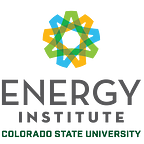Energy Institute students participate in NASA program, build atmospheric measurement devices
Over the summer, six students from the CSU Energy Institute traveled to Deer Trail, Colo. for the culmination of a project through the Colorado Space Grant Consortium (COSGC). The COSGC is a state-wide organization funded through NASA that gives students the chance work with engineers and scientists to develop and test space related technologies.
The six CSU students worked on Demosat, which is one of the statewide programs that the COSGC offers. They were challenged to design, build, launch and recover a device attached to a balloon that would record scientific data as it floated though layers of the atmosphere up to 100,000 feet.
Adam Friss is a doctoral student in mechanical engineering and works under professor Azer Yalin, professor of mechanical engineering and CSU affiliate director for COSGC since 2007. Friss, a NASA Space Technology Research Fellow, managed the students by providing design and technical guidance, as well as taking care of day-to-day logistics. “I think it is important, because it exposes students to real-world engineering and working on a team. Most of what you learn in undergrad is idealized, so real-world engineering problems are an incredibly valuable teaching tool.”
The CSU students were split into two teams of three. Team Ultraviolet Voodoo — UVVDU for short — designed their device to record data of UV radiation and microbes (such as mold, fungus and bacteria) through layers of the upper atmosphere. “The main purpose is to have a UV data model as you go through the atmosphere, which is lacking a little bit,” explained Rachel Jackson, a member of the team and junior in chemical and biological engineering at CSU. “We have data points for surface level at 12km and 300km, but we don’t really have a gradient as you go up and down through the atmosphere,” she said.
Understanding this is valuable, because when space crafts return through the upper atmosphere, microbes that humans may not be adapted to can cause contamination and pose a health risk. Since UV light can kill organisms, it’s important to understand the range of both. Though the team didn’t collect biological data this round, they successfully recorded UVA radiation.
“By correlating the UV radiation data with the microbial growth, we can see the certain adaptations that the microbes have to increased exposure to radiation, as well as the extreme environments that are experienced in the upper atmosphere,” said Jackson. “We used a microcontroller to record the data, and we had a bunch of different sensors on there,” she added.
The other team, AEROSOLution, built a device intended to collect aerosols and ozone readings at various elevations. Aerosols, or particulates, are tiny particles of material in the atmosphere that can affect climate and human health.
A rotating filter inside the team’s device collected these particles during the launch, but because of a problem with the payload’s altimeter (a device that measures altitude), some of the filters weren’t exposed — an example of how students get to experience trial and error for themselves. “After [232 feet] it just stayed open on the first filter, so we captured particulates in the first filter, but everything else was not exposed,” said Michael Sartini, a senior in mechanical engineering at CSU, adding on a positive note, “But the ozone readings were good, and it’s calibrated so we have an ozone model of the altitudes.”
“My favorite part has been watching the students solve problems in real time. It is rewarding to see someone develop a deeper understanding and to have those ‘aha’ moments.” — Adam Friss
This is one of many ways the Energy Institute gives students an opportunity to learn interactively and meet professionals in their field. Learn more about ways the CSU Energy Institute and partners help students of all ages gain hands-on experience in STEM areas.
